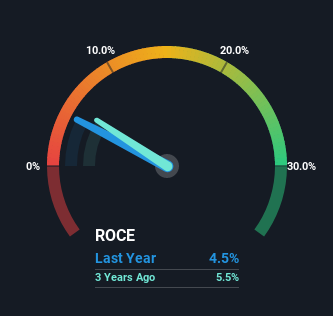- United States
- /
- Entertainment
- /
- NYSE:LYV
Investors Met With Slowing Returns on Capital At Live Nation Entertainment (NYSE:LYV)

What trends should we look for it we want to identify stocks that can multiply in value over the long term? Amongst other things, we'll want to see two things; firstly, a growing return on capital employed (ROCE) and secondly, an expansion in the company's amount of capital employed. If you see this, it typically means it's a company with a great business model and plenty of profitable reinvestment opportunities. Although, when we looked at Live Nation Entertainment (NYSE:LYV), it didn't seem to tick all of these boxes.
What Is Return On Capital Employed (ROCE)?
For those that aren't sure what ROCE is, it measures the amount of pre-tax profits a company can generate from the capital employed in its business. The formula for this calculation on Live Nation Entertainment is:
Return on Capital Employed = Earnings Before Interest and Tax (EBIT) ÷ (Total Assets - Current Liabilities)
0.045 = US$353m ÷ (US$16b - US$8.6b) (Based on the trailing twelve months to June 2022).
Therefore, Live Nation Entertainment has an ROCE of 4.5%. In absolute terms, that's a low return and it also under-performs the Entertainment industry average of 6.1%.
Our analysis indicates that LYV is potentially undervalued!

Above you can see how the current ROCE for Live Nation Entertainment compares to its prior returns on capital, but there's only so much you can tell from the past. If you'd like, you can check out the forecasts from the analysts covering Live Nation Entertainment here for free.
What Does the ROCE Trend For Live Nation Entertainment Tell Us?
The returns on capital haven't changed much for Live Nation Entertainment in recent years. The company has employed 76% more capital in the last five years, and the returns on that capital have remained stable at 4.5%. Given the company has increased the amount of capital employed, it appears the investments that have been made simply don't provide a high return on capital.
Another thing to note, Live Nation Entertainment has a high ratio of current liabilities to total assets of 53%. This can bring about some risks because the company is basically operating with a rather large reliance on its suppliers or other sorts of short-term creditors. Ideally we'd like to see this reduce as that would mean fewer obligations bearing risks.
The Bottom Line On Live Nation Entertainment's ROCE
Long story short, while Live Nation Entertainment has been reinvesting its capital, the returns that it's generating haven't increased. Although the market must be expecting these trends to improve because the stock has gained 87% over the last five years. Ultimately, if the underlying trends persist, we wouldn't hold our breath on it being a multi-bagger going forward.
Live Nation Entertainment does have some risks though, and we've spotted 1 warning sign for Live Nation Entertainment that you might be interested in.
While Live Nation Entertainment isn't earning the highest return, check out this free list of companies that are earning high returns on equity with solid balance sheets.
New: AI Stock Screener & Alerts
Our new AI Stock Screener scans the market every day to uncover opportunities.
• Dividend Powerhouses (3%+ Yield)
• Undervalued Small Caps with Insider Buying
• High growth Tech and AI Companies
Or build your own from over 50 metrics.
Have feedback on this article? Concerned about the content? Get in touch with us directly. Alternatively, email editorial-team (at) simplywallst.com.
This article by Simply Wall St is general in nature. We provide commentary based on historical data and analyst forecasts only using an unbiased methodology and our articles are not intended to be financial advice. It does not constitute a recommendation to buy or sell any stock, and does not take account of your objectives, or your financial situation. We aim to bring you long-term focused analysis driven by fundamental data. Note that our analysis may not factor in the latest price-sensitive company announcements or qualitative material. Simply Wall St has no position in any stocks mentioned.
About NYSE:LYV
Live Nation Entertainment
Operates as a live entertainment company worldwide.
Proven track record with adequate balance sheet.
Similar Companies
Market Insights
Community Narratives



